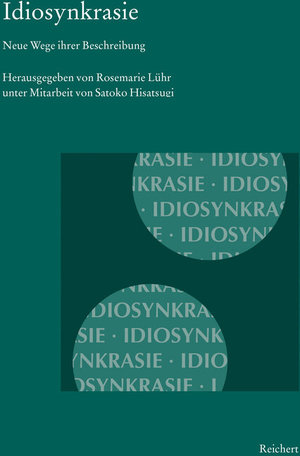
Idiosynkrasie
Neue Wege ihrer Beschreibung
In Verbindung mit Syntax oder syntagmatischen Relationen ist der Begriff Idiosynkrasie
kaum verwendet worden. Dass geprüft werden muss, ob es sich tatsächlich um idiosynkratische Phänomene handelt, zeigen die folgenden Beiträge aus der Indogermanistik. Unter einem weiten Begriff von Idiosynkrasie werden syntaktische Trennungszeichen in alten Inschriften, Null anaphora, die Syntax von Objekten, das Hyperbaton, idiosynkratische dass-Sätze und Idiosynkrasien in der Informationsstruktur behandelt. Die Daten stammen aus den Sprachen Hethitisch, Altindisch, Griechisch, Latein, Venetisch, Runennordisch, Walisisch, Älteres Deutsch. Untersuchungsfragen sind: Sind Idiosynkrasien in der Syntax tatsächlich „Unregelmäßigkeiten“ oder sind sie durch noch nicht entdeckte Regeln erklärbar? Wie entstehen Idiosynkrasien historisch? Wie werden sie beseitigt?
Syntagmatische Relationen auf Wortebene können syntagmatische Interpunktionen
sein. In Inschriftenkorpora alter Sprachen erscheint die Setzung von Trennungszeichen zur Kennzeichnung syntaktischer Strukturen dann als unregelmäßig, wenn sie aus den vorhandenen Systemen nicht erklärbar ist. Das zeigt sich an der Art von Idiosynkrasien in Runeninschriften im älteren Fuþark und an venetischen Inschriften.
Die scheinbar idiosynkratische Struktur in der Distribution von Nullobjekten und Klitika in alten indogermanischen Sprachen ist durch die Verbsemantik bedingt. Verben sind in altindogermanischen Sprachen mehr Aspekt orientiert, wodurch das Gesamtereignis und weniger die Partizipianten im Zentrum stehen. Das Pronomen fehlt dann nicht nur, weil es auffindbar ist, sondern weil sich die Aufmerksamkeit auf das Verbalgeschehen richtet.
Im Walisischen kommen analytisch und synthetisch gebildete Verben und auch Nullelemente vor. Das morphologische Verhalten finiter Verben in Verbindung von prononominalen und, nichtpronominalen Subjekten wie auch von koordinierten und nichtkoordinigerten Subjekten hängt mit der funktionalen Entwicklung schwacher Subjektpronomina zusammen.
Die Unterschiede in der Verwendung des Hyperbatons, einer hochgradig idiosynkratischen
sind im Altindischen und Hethitischen beträchtlich. Während es im Altindischen keinerlei Restriktionen beim Hyperbaton gibt, ist diese Redefigur im Hethitischen sehr selten belegt.
Eine scheinbare Idiosynkrasie der Satzsyntax ist die Konjunktion dass als satzeinleitendes Element in deutschen Exklamativsätzen mit Verbendstellung. Vergleichbare Sätze machen unter bestimmten pragmatischen Bedingungen deutlich, dass dass kein zu einem idiosynkratischen Merkmal gewordenes Relikt aus früheren Zeiten ist.
Zur Auflösung vermeintlicher Idiosynkrasien tragen auch informationsstrukturellen Analysen, die das Topik des Satzes betreffen bei. Da Aboutness Topiks häufig Textkohärenz herstellen, wird verständlich, warum gerade die zweite Position die bevorzugte Position für das Topik wurde. Eine Topik-Position an der zweiten Satzstelle ist somit keine Idiosynkrasie.
Die Behandlung aller dieser Fragen ist in der Indogermanistik neu.
Until now the concept of idiosyncrasy has been hardly associated with syntax or syntactic relations. The following contributions of Indo-European linguistics show that it must be examined if there are indeed idiosyncratic syntactic phenomena. Under a broad concept of idiosyncrasy, hyphens in old inscriptions, null anaphora, the syntax of objects, the hyperbaton, idiosyncratic dass-clauses and idiosyncrasies in information structure are treated. The data comes from Hittite, Old Indic, Greek, Latin, Venetic, Runic Norse, Welsh, Early New High German. Research questions are: Are idiosyncrasies in syntax actually irregularities or must they be explained by not stated rules? How do idiosyncrasies emerge historically? How are they being dealt with?
Syntagmatic relations on word level may be syntagmatic punctuations. In inscriptions of ancient languages hyphens work as representations of idiosyncrasies, if they cannot be explained from the existing systems. Evidence comes from Runic inscriptions in older Fuþark and Venetic inscriptions.
In old Indo-European languages the seemingly idiosyncratic structure in the distribution of null objects and clitica is due to verb semantics. In these languages verbs are oriented on aspect, whereby the event as a whole is at the center and less the participants. The pronoun is missing then not only because it is discoverable but because attention is focused on the verbal action.
In Welsh verbs formed analytically and synthetically are documented together with null elements. It is argued that the morphological behavior of finite verbs in context of either pronominal or non-pronominal and of either coordinated or non-coordinated subjects has to be attributed to the special functional development of weak subject pronouns.
The differences in the use of the hyperbaton in Old Indic and Hittite are substantial. While in Old Indic there are no restrictions on the hyperbaton, in Hittite this figure of speech is very rare. The hyperbaton is a highly idiosyncratic category because what belongs together is separated.
An apparent idiosyncrasy of sentence syntax is the conjunction dass as sentence-introductory element in German exclamatory sentences with verb-final order. Similar clauses under special pragmatic conditions, however, clearly indicate that dass is no idiosyncratic relic of earlier times.
Also information structural analyzes relating to the sentence topic contribute to the resolution of supposed idiosyncrasies. As Aboutness Topics frequently establish text coherence, namely by pronouns being marked as weak, it becomes comprehensible why just the second position is the preferred position in the sentence. A Topic in this position is thus no idiosyncrasy.
The treatment of all these issues is new in Indo-European linguistics.






